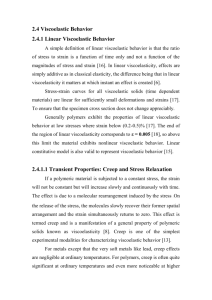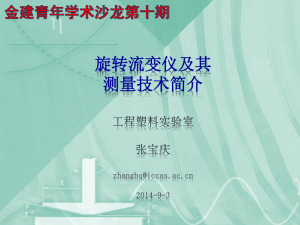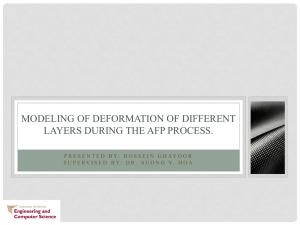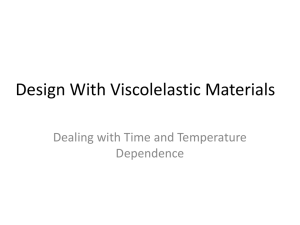Time-Dependent Properties
advertisement
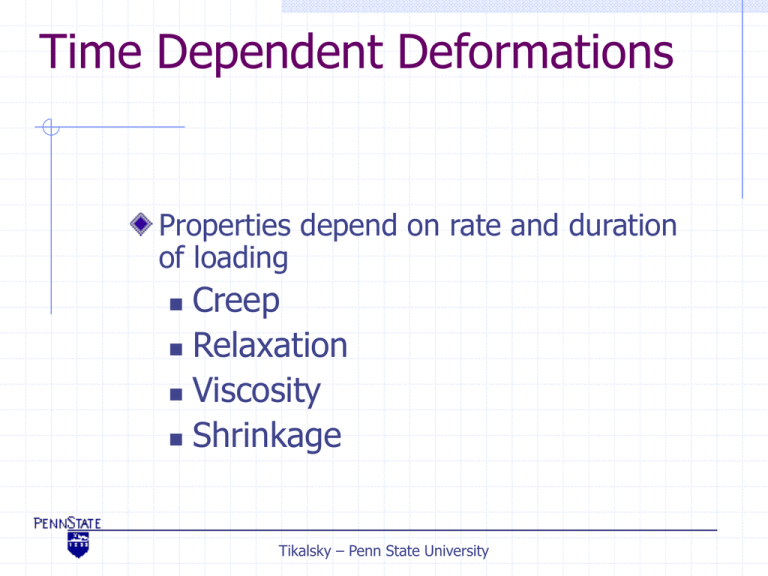
Time Dependent Deformations Properties depend on rate and duration of loading Creep Relaxation Viscosity Shrinkage Tikalsky – Penn State University Review: Elastic Behavior Elastic material responds to load instantly Modulus of Elasticity = ds/de Stress Material returns to original shape/dimensions when load is removed Strain Energy and strain are fully recoverable Tikalsky – Penn State University Stress – Strain Curve Modulus of Elasticity Modulus of Toughness: Total absorbed energy before rupture Modulus of Resilience: Recoverable elastic Energy before yield Ductility: Ratio of ultimate strain to yield strain Tikalsky – Penn State University Creep Time dependent deformation under sustained loading Tikalsky – Penn State University Creep Behavior Stress changes the energy state on atomic planes of a material. The atoms will move over a period of time to reach the lowest possible energy state, therefore causing time dependent strain. In solids this is called “creep”. In liquids, the shearing stresses react in a similar manner to reach a lower energy state. In liquids this is called “viscosity”. Tikalsky – Penn State University Idealized Maxwell Creep Model Maxwell proposed a model to describe this behavior, using two strain components: s e 1s/E Creep Rate s e e2 de 2 dt e2 s dt 0 Elastic strain, e1= s/E Creep strain, t e1 Tikalsky – Penn State University s = constant s time Creep Prediction Creep can be predicted by using several methods Creep Coefficient ecreep/eelastic Specific Creep ecreep/selastic Tikalsky – Penn State University Primary Strain Temperature Secondary Tertiary Ambient Temperature Time Tikalsky – Penn State University Primary Strain Creep Behavior changes with Stress High Temperature Secondary Tertiary Low Stress Tikalsky – Penn State University Time Relaxation Time dependent loss of stress due to sustained deformation Strain Relaxation Behavior Stress t t to Tikalsky – Penn State University Idealized Relaxation Model Maxwell’s model can be used to mathematically describe relaxation by creating a boundary condition of , de dt 0 d s 0 dt E t 0 ds s ln t 0 t dt 0 s s0 1 ds s dt E dt s E E dt ln s s0 t s s 0e Tikalsky – Penn State University E Et t Plot of Relaxation s s s 0e Et s0 time e = constant Tikalsky – Penn State University Viscosity Viscosity is a measure of the rate of shear strain with respect to time for a given shearing stress. It is a separating property between solids and liquids. Material flows from shear distortion instantly when load is applied and continues to deform Higher viscosity indicates a greater resistance to flow Solids have trace viscous effects As temperatures rise, solids approach melting point and take on viscous properties. Tikalsky – Penn State University Viscous Behavior Energy and strain are largely non-recoverable Shear Stress Viscosity, t / dg/dt t, sec shear strain rate = dg/dt Shear Strain dg/dt t0 t, sec is coefficient of proportionality between stress and strain rate Tikalsky – Penn State University Shrinkage Shrinkage deformations occur in hydrous materials Loss of free water, capillary water, and chemically bound water can lead to a deduction of dimensions of a material Organic materials like wood shrink and/or expand over time, depending on the ambient environmental conditions. Hydrous materials like lime mortar shrink over time. The rate of shrinkage is largely related to relative humidity. Tikalsky – Penn State University Shrinkage Mechanism e 0 The loss of capillary water is accomplished by a variety of mechanisms Heat Relative Humidity Ambient Pressure Stress (mathematically included in creep) Shrinkage can also be related to the dehydration of hydrated compounds CaSO4*2H2O (gypsum) to CaSO4*½H2O or Ca(OH)2 to CaO. This type of dehydration is also accompanied with change in mechanical strength properties. Tikalsky – Penn State University e0esh Summary of time dependent effects Creep Relaxation Viscosity Shrinkage Temperature increases deformation Microstructure of material Atomic structure Crystalline Amorphous Bonding Tikalsky – Penn State University
